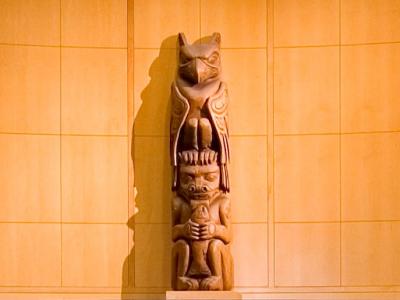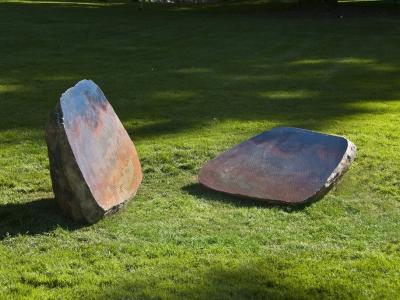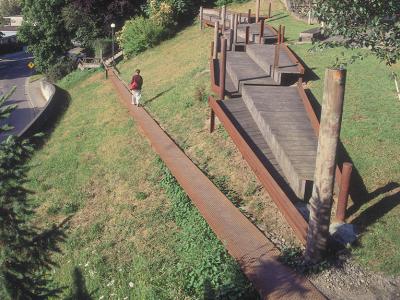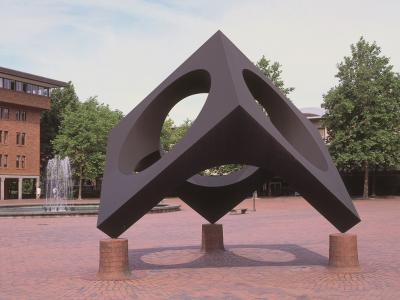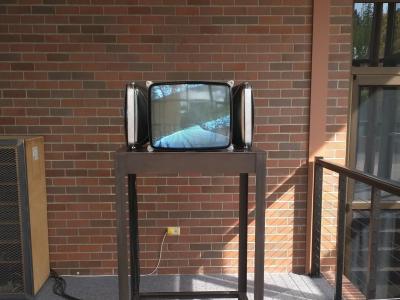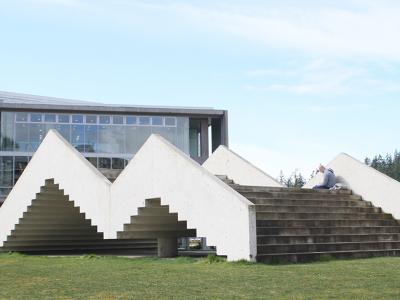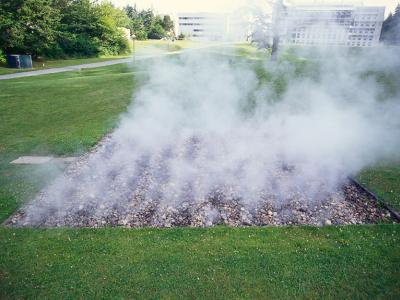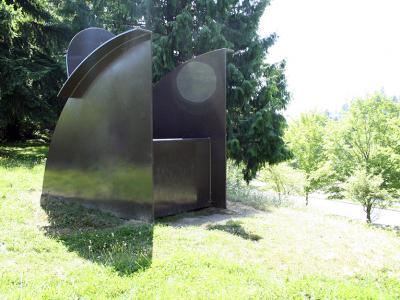Anthony Caro, India, 1976
Anthony Caro, 1976.
Steel, rusted and varnished. 7 3/4' h. x 9 3/4 ' w.
Photo credit: Sandra Lucke
Gift from the Virginia Wright Fund, 1977.
Description
Walk around the sculpture with Google Street View
Caro's sculpture relates to human scale and to architectural detail. There is a strong frontality to "India," like vertical planes of a door, panel or room divider. Yet each side gives dramatically different views. On one side organic lumps thrust diagonally against large planes. Caro was aware of the country of India's architecture encrusted with ever moving body parts of various deities and their attendants. But also important to his concept was the material of steel and the rolling mills involved in its process - lumps flattened to a slab, then a sheet.
When the art committee took over the selection of artists from the architects, the visiting artists were permitted to find their own site or context. If Anthony Caro is one of the few who did not actually visit the campus, one might question if his piece is placed to its best advantage and whether his work responds to the architectural environment. Despite his not siting the work himself, Caro has said, "I am pleased to hear that India is in an enclosed area, surrounded on three sides by buildings, but with the buildings sufficiently far away not to compete with it or obstruct the view. It [seems] as if the siting has been very sensitive."
Full text
Early in his career, Caro had been interested in representing the human figure in an expressive manner while still emphasizing the body's weight. While he was in the United States in the early sixties, he changed to a totally abstract mode using units of industrial preformed steel (I-beams, bars or railings, mesh screens, etc.) in his concern to more effectively imply an architectonic order. He continued to dispense with the conventional pedestal and oriented his sculpture horizontally along the floor or ground. One critic found that, instead of having an actual body, Caro's figuration had to do with its lively horizontal and vertical movement in its static, albeit abstract, frame. Also the critic felt he could say that Caro's internal forms-the different sizes of planar shapes-emerged gradually, as in music. While Caro himself has often stated that his relational mode of working is parallel to music, he and other critics today speak more openly about “architectural detail."
Favoring a more human scale, Caro had disliked the type of public sculpture that was being forced to match the scale and meaning of a public building. Yet, he always has been attuned to the reinvention of sculpture in relation to architecture. He has stated that the adjectives "sculptural" and "bodily" are similar in that both imply a physicality -"a type of felt relation to our bodies' size [verticality] and stretch [horizontality]" as well as weight and gravity. Furthermore, he feels that both "sculptors and architects are necessarily conscious of the body."
In the seventies Caro wanted a more monumental look to his sculptures, which earlier had been placed running in rectilinear directions along the top of the ground. Moving from the floor of his studio, he stepped outside to work with a crane operator in a steel yard. There, he chose large flat pieces of steel to lean against each other so that the work had a stronger vertical stance with a front and back view. The multi layered planes gave a compressed sense of volume and, as in India, the small, open cut-out area joining the right and left sides even suggested the possibility of looking into something. Rather than scaling itself to a tall building, for example, the adjacent Old Main (1896 building on first quad), Caro's sculpture relates to human scale and to architectural detail. There is a strong frontality to India-like the vertical planes of a door panel, or room divider. Each side gives dramatically different views; at the back, smaller, uneven shapes activate the unpainted, pitted, and corroded surfaces and at the front, organic lumps thrust diatonically against the large planes.
When India was completed, one critic commented on its combination of urban and pastoral imagery. While he probably was specifically referring to a lingering figuration in the lumps reminding him of Caro's past apprenticeship with Henry Moore, he also suggested he saw an urban quality probably connected with Great Britain's industrialism, present and past. In the seventies, Caro worked in the steel yards in Veduggio, Italy, and York, Canada, and would travel in his own country to the County of Durham to find material. There the workers at Consett also sent steel along rollers to be flattened from a lump to a slab to a sheet for future boilers, ships, and car bodies, just like those auto parts in Steve Tibbetts' sculpture. Yet, another critic stated that these steel lumps in India "evoked outcroppings of prehistoric rock pushing through the earth’s surface, the hidden recesses of cave formations. . . ." Another found that the upright planes "sheltered secret sculptures tucked under the overhanging planes. . . ." Perhaps, when Caro stated that "walking into a building and walking around a building are different," he was remembering the Indian ritual of circumambulating a temple but also the details of those temples. "Prevalent in India are rock caves with interior religious sculptures and/or towering architecture encrusted with ever moving body parts of various deities and attendants. Now we know that Caro has always wanted to cross the boundaries of sculpture and architecture, to address the same subject-the relation of form and space in a way that makes sense in human terms.
© Sarah Clark-Langager


